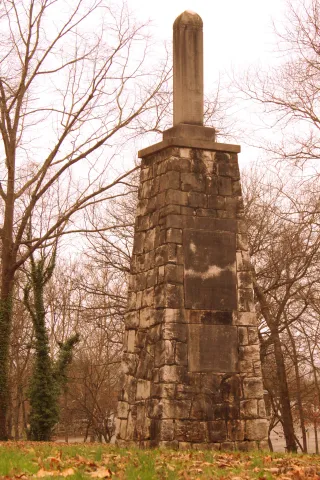Knox County Potter's Field

Late one summer several years ago, I had the opportunity to walk into history-to explore a historical site that has been inaccessible for years. Sealed off from the public not by walls or fences but brush and bramble the interior of Knox County Potter's Field had been impenetrable for decades. In recent years, a trail had been blazed to the monument erected to indigent dead in 1937, but by spring of 2007 it had also become impenetrable.
After making a call to the City of Knoxville requesting that the trail be cleared, I was both surprised and delighted at the quick response to my request. I was even more delighted later as crews began to clear the dense undergrowth that had prevented me from exploring this historic ground.
A Potter's Field is an indigent cemetery. Throughout Christendom indigent cemeteries are known as Potter's Field-a tradition that goes back to the crucifixion. After Judas betrayed Christ, he returned to the temple with his thirty pieces of silver. When the priest refused to accept the money, he threw it down before hanging himself. Unable to accept blood money into the treasury, they took Judas' thirty pieces of silver and bought a Potter's Field, a ruined piece of ground, in which to bury strangers.
Knox County Potter's Field is on Kyle Street at Bethel Avenue. Marked graves date back to before the Civil War when it was originally established as Belleview Cemetery-a for profit cemetery. It was not a success and was in a few years purchased by the county to be used as an indigent cemetery.
Years before being obscured by dense vegetation, Knox County Potter's Field was front page news. In late February 1903, a scandal erupted involving a local undertaker contracted by the county for the burial of indigent dead. Josh Payne, cemetery sexton, and his son, Lloyd, who assisted with the digging of graves had observed a recent spike in the number of indigent burials. Considering the additional work involved for them, it is no surprise that they would have taken notice.
Exhumations soon began. Over one hundred graves were opened. Over three quarters were found not to contain human remains. Some contained buggy parts and other household junk intended to deceive those involved in the interments. Before long, crowds had begun to gather at the cemetery to observe the process.
Years later, in 1937, about the time that the cemetery closed to new interments a monument was erected to the indigent dead at the "order of Knox County Court"-the predecessor of today's county commission. From the street, the base, constructed of cut limestone, looks like a chimney that might have stood next to a log home with an obelisk on top. Upon closer inspection, the base is more the size of a chimney that might have stood next to an iron furnace.
Inscribed is an excerpt from Thomas Gray's "Elegy Written in A Country Churchyard." The names of both the Old Gray & New Gray Cemeteries were inspired by Gray's famous poem, but neither have posted an excerpt. Gray's country churchyard was a humble place where people of modest means were interred. The Old Gray Cemetery was a Victorian Garden Cemetery primarily marketed to the well to do of the era although the graves of those of more modest means can also be found near the northwest corner. The New Gray appears to have begun with a similar plan.
Spring is an ideal time to plan a walk into history at Knox County Potter's Field. Also known as cemetery ivy, Myrtle was used as a common ground cover in cemeteries before the proliferation of lawn mowers. Other types of ivy and day lilies near the monument to the indigent dead were also apparent. All winter, I waited to see what other types of spring flowers might make their presence known in the interior of the cemetery which over years of neglect had grown in to an urban forest. To my delight, daffodils scattered throughout the cemetery are now in bloom. Years ago, it was common for people to plant daffodils and other perennials on and around the graves of loved ones.
Weather permitting, at 2:00p.m. on Saturday April 28, I will return to the Potter’s Field, 305 South Kyle Street, in Knoxville, to host an annual presentation on the history of the cemetery. My intent is to memorialize those who rest beneath the soil, to advocate for the dignified preservation of their burial ground, and to warn of the potential spectre of another Gilded age. For more information please contact me at JoeStephens10@hotmail.com
Photo by Brent Moore
- Log in to post comments